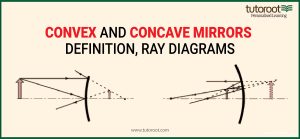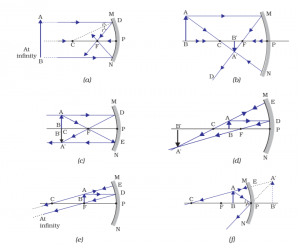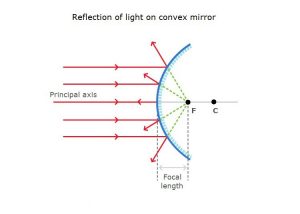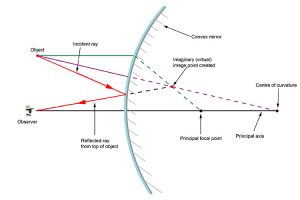Convex Mirror & Concave Mirror – Definition, Ray Diagrams, Formulae 2024
In Physics, students often encounter the term, spherical mirrors, while learning about how light is deflected and at what angles. Several concepts and chapters are directly derived from it. There are two types of spherical mirrors, Convex Mirrors and Concave Mirrors.
Convex mirrors and concave mirrors differ in their principles. In simple terms, convex mirrors bulge outside whereas the concave mirror bulges from inside.
Tapering figures represent convex mirrors while broadening ones refer to concave mirrors.
While, both, convex and concave mirrors have different principles, the complexities and comparisons need to be dealt with elaborately. From plane to spherical mirrors, to concave to convex mirrors, the differences attach immense importance to physics students, as well we those who deal with as part of academics as well as profession.
In this article, we are happy to take you through various aspects of convex mirrors and concave mirrors. We cover:
- Convex mirror uses
- Concave mirror uses
- Convex mirror examples
- Concave mirror examples
- Characteristics of convex mirrors
- Characteristics of concave mirrors
- Convex mirror diagrams
- Concave mirror diagrams
Through ray diagram, as well as formula, we will also help you understand the difference between concave mirror and convex mirror, more clearly
What are Plane Mirror and Spherical Mirror?

However, before we delve into types of convex mirrors and concave mirrors, let us first talk about the basics of Plane Mirrors and Spherical Mirrors, and how they are different from each other, as well as their applications.
Plane Mirror
A plane mirror is a mirror that has a flat and smooth surface, which in turn, always forms a virtual form of the object, with exact shape and size, when it reflects. Commonly, plane mirrors are those which people generally use in dressing rooms or makeup tables. A plane mirror is known for providing exact image.
A plane mirror is used for a wide range of applications and purposes that include periscopes and kaleidoscopes, auto industry, mirrors for domestic use, medical especially dental, and torch lights, besides security-related purposes.
In terms of physics, when light rays hit a plain mirror, the angle of reflection will be the same as the angle of incidence. In plain mirrors, the images are generally laterally inverted, and are erect. The focal length of a plain mirror is counted as infinity.
Spherical Mirror
Spherical mirrors are also referred to as curved mirrors, where they have a shape cut out of the spherical surface. Under a spherical mirror, there are two categories: convex mirror and concave mirror. The spherical mirror and its equation hold significant importance in science, owing to its association with optics.
Unlike plane mirrors, spherical mirrors, both convex mirrors and concave mirrors, have a radius if curvature with a consisting curve, which results in the formation of an image, that can be either virtual or real.
What is a Concave Mirror?
A Spherical Mirror that has a reflective surface inside, is called the converging mirror. The main attribute of the concave mirror is that it focuses on pointing the light from the source falling on it, into a single point. And generally, the image formed by these types of mirrors usually varies based on the size, shape, and position of the object.
Characteristics of Concave Mirror
The major characteristics of concave mirrors are listed below,
- Converging: A concave mirror is a converging one because, light rays that hit it reflect on the surface, and merge at a particular point. This point is known as a focal point. Concave mirrors allow light to focus to a point.
- Magnification and formation of image: Place a concave mirror close to any object and you will notice that it shows a magnified image that is straight, erect, and of course virtual. The image looks to be larger than the actual size of the object. The concave mirror also looks upright. The reason why concave mirrors feature the formation of virtual images is that the rays that reflect look to diverge from a point located behind the mirror.
- Distance and image properties: In concave mirrors, when the distance between the object and the concave mirror increases, the size of the image decreases. At a particular distance, , the image changes to virtual. Under this circumstance, the true image, in an inverted form manifests on the opposite side of the concave mirror.
- Image formations: concave mirrors create images of different sizes, and diverse in nature, from real to virtual. These features enhance the importance of concave mirrors, which they are widely used in various applications, from domestic to scientific
Image Formation by Concave Mirror
The image formed by the concave mirror is either real or virtual and can be small and large based on the position of the sources, and the reflecting point.
For example, if the distance of the object from the source is large, then it results in real and inverted images. Whereas for the objects placed close to the source, the images formed are erect and virtual.
Moreover, in this mirror, the light converges at a single point before reflecting, which is referred to as a converging mirror.
Ray Diagram of Concave Mirror
The Ray diagram of concave mirror is shown below along with the object placing.
- The object is at Kept at Infinity: When the parallel rays meet or converge at the Principal Focus, F. So when the object is kept at Infinity, the image will form here at the F. The image formed by this ray diagram is a point-sized, highly diminished, inverted, and real image.

- Object is placed at infinity and Centre of Curvature: Only diminished images are formed that are either real or inverted.Object at Centre of Curvature(C): The image of the same size is formed, that is inverted or real.
Object between Principal Focus and Centre of Curvature
- Object at Principal Focus(F): A highly enlarged image, that is inverted and real.
- Object between Principal Focus(F) and Pole(P): Similarly enlarged is formed.
It is the complete description of the ray diagram of concave mirror when the object was placed at various points.
What is a Convex Mirror?
Convex mirror is also a spherical mirror and is exactly opposite of concave mirrors in its properties.
Let us first understand convex mirror through its basic definition:
A convex mirror is a type of spherical mirror that has a reflective surface towards the outside of the bulge, and it is also referred to as diverging mirror. Unlike convex mirrors, in a concave mirror, the light falling on the object diverges as it reflects through the mirror. And generally, as the distance between the source and the object decreases, the size of the image formed increases.
Characteristics of Convex Mirror
- Diverging: A convex mirror is a standard diverging mirror because when light rays hit the reflecting surface, they diverge or spread. Unlike concave mirrors, convex mirrors cause the light rays to diverge from the definite focal point.
- Types of images – from virtual to diminishing: irrespective of the distance between the object and the convex mirror, the images formed are virtual, uprights, and diminished. The image appears erect and smaller too compared to the actual size of the object. The image also appears on the rear side of the mirror. When you trace it backward, the virtual image forms through the intersection of diverging rays.
- View–Wide: Convex mirrors have an incredible feature to offer a broad canvas of view. This is because they possess an outwardly curved shape, and thus convex mirrors capture a wider area in reflection in comparison with flat and concave mirrors. Due to this, concave mirrors are used whenever there is a need for a larger perspective and a more expansive view. These can be large grounds for parking, sporting, meeting, and intersections, and where security, surveillance, and monitoring are involved
- Image – magnitude, and distance: convex mirrors are known to produce virtual images that are closer to the mirror than the object. The image that is formed by convex mirrors looks diminished and gives an impression of being smaller than the object’s real size. Due to this reduction, in the size of the image, a more expansive area can be captured for reflection.In summary, through convex mirrors, the light diverges as it strikes the reflecting surface The Convex mirrors always result in diminished, erect, and virtual images, regardless of the distance between the mirror and the object.
Ray Diagram of Convex Mirror
The Ray diagram of convex mirror is shown below along with the object placing.
- Object at Infinity: A point-sized image is generally formed at the principal focus behind the convex mirror.

- Object is kept between Infinity and Pole: If the object is placed in between the pole and infinity of a convex mirror, a diminished, erect, and virtual image at the pole is located in mid-point, focus, and pole.

It is the complete description of the ray diagram of convex mirror when the object was placed at various points.
Image Formation by convex mirrors and concave mirrors
As we dwell deeper into the ray incidence on concave and convex mirrors, it becomes easier for us to ascertain and understand the characteristics and behavior of light rays. This is particularly helpful in building precise ray diagrams and analyzing image formation processes.
Oblique Incidence: When a ray hits the mirror at its pole, its reflection is oblique, forming the same angle as the principal axis. This ensures the angle of incidence is equal to the angle of reflection, thus extending the symmetry of the reflected rays.
Parallel Incidence: When a ray that is parallel to the principal axis hits the concave mirror or a convex mirror, it takes a definite trajectory. If it is a concave mirror, the ray goes through the focus on the principal axis. If it is for a convex mirror, the reflected ray is born out of the focus on the same side as the incident ray.
Focus Incidence: When a ray passes through the focus and hits the surface of a concave mirror or a convex mirror, it will be seen traveling parallel to the principal axis. This is the same for both concave and convex mirrors.
Centre of Curvature Incidence: When a ray travels through the center of curvature of a spherical mirror it will retrace its path after reflection. This is nothing but going through reflection and following the exact similar path in the opposite direction, when the ray touches the centre of the curvature.
Difference Between Concave and Convex Mirror
| Mirror Type | Concave | Convex |
| Description | The Inner Side of the mirror is reflecting, converging mirror | The Outer side of the mirror is reflecting, diverging the mirror |
| Image Formed | Both Inverted, Real and Virtual, Erect images are formed | Only Virtual and Erect images are formed |
| Size of Image | Depending on the distance of the object, the size of the image varies | The size of the image is smaller compared to the size of the object |
| Position of the Image | Directly depends on the Position of the Object. | Does not depend on the Position of the Object, as the image is always formed within Focus. |
Convex and concave mirrors – important aspects
- Pole: The center point of any spherical mirror from where all measurements are made
- Aperture: An aperture of a mirror is an origin point of reflection of light
- Principal axis: This is an imaginary line passing through the optical center and from the center of curvature of a mirror. Generally, measurements are taken based on this line
- Centre of Curvature: this is a point in the center of the surface of a mirror and goes through the mirror curve, having the same tangent and curvature at the point.
- The radius of Curvature: This is the linear distance between the pole and the center of curvature.
- Principal Focus: This is the Focal Point and is there on the mirror axis.
- Focus: It is a point on the principal axis where light rays parallel to the principal axis come together after reflecting from the mirror.
Examples of Concave Mirrors
The examples of concave mirrors are listed below,
- Shaving and other domestic mirrors
- Telescopes
- Ophthalmology
- Vehicles as headlights
- solar furnaces
Examples of Convex Mirrors
The examples of convex mirrors are listed below,
- Office space, industrial complexes, stores, healthcare, and residential buildings
- In vehicles as rear-view mirrors
- Security purposes
- As magnifying glasses
- Large public spaces and grounds
Conclusion
In the above article, we have provided a comprehensive description of both Concave and Convex Mirrors. We hope this article cleared the complete information of Ray Diagrams of concave mirrors and ray diagrams for convex mirrors and the differences. Besides, the types of mirrors, use of convex mirrors, use of concave mirrors.
As you are aware, many topics such as this in Physics are often complex, and the students often end up struggling to understand these topics and subjects. So, in this process, it is wiser to join an online coaching platform that offers various amazing features for the students to get a better grasp of the subject. One such online tutoring platform is Tutoroot, which offers online interactive classes for students in a personalized, yet effective manner. Enroll with Tutoroot today
